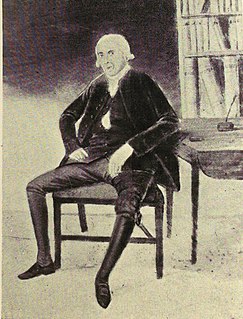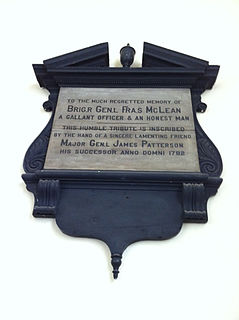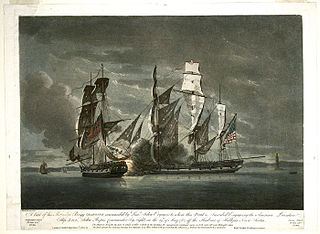
The Penobscot Expedition was a 44-ship American naval armada during the Revolutionary War assembled by the Provincial Congress of the Province of Massachusetts Bay. The flotilla of 19 warships and 25 support vessels sailed from Boston on July 19, 1779 for the upper Penobscot Bay in the District of Maine carrying an expeditionary force of more than 1,000 American colonial marines and militiamen. Also included was a 100-man artillery detachment under the command of Lt. Colonel Paul Revere.

Loyalists were American colonists who stayed loyal to the British Crown during the American Revolutionary War, often referred to as Tories, Royalists, or King's Men at the time. They were opposed by the Patriots, who supported the revolution, and called them "persons inimical to the liberties of America". Prominent Loyalists repeatedly assured the British government that many thousands of them would spring to arms and fight for the crown. The British government acted in expectation of that, especially in the southern campaigns in 1780–81. In practice, the number of Loyalists in military service was far lower than expected since Britain could not effectively protect them except in those areas where Britain had military control. The British were often suspicious of them, not knowing whom they could fully trust in such a conflicted situation; they were often looked down upon. Patriots watched suspected Loyalists very closely and would not tolerate any organized Loyalist opposition. Many outspoken or militarily active Loyalists were forced to flee, especially to their stronghold of New York City. William Franklin, the royal governor of New Jersey and son of Patriot leader Benjamin Franklin, became the leader of the Loyalists after his release from a Patriot prison in 1778. He worked to build Loyalist military units to fight in the war, but the number of volunteers was much fewer than London expected.

The Boston campaign was the opening campaign of the American Revolutionary War, taking place primarily in the Province of Massachusetts Bay. The campaign began with the Battles of Lexington and Concord on April 19, 1775, in which the local colonial militias interdicted a British government attempt to seize military stores and leaders in Concord, Massachusetts. The entire British expedition suffered significant casualties during a running battle back to Charlestown against an ever-growing number of militia.

The Fortification of Dorchester Heights was a decisive action early in the American Revolutionary War that precipitated the end of the siege of Boston and the withdrawal of British troops from that city.

The 84th Regiment of Foot was a British regiment in the American Revolutionary War that was raised to defend present day Ontario, Quebec and Atlantic Canada from the constant land and sea attacks by American Revolutionaries. The 84th Regiment was also involved in offensive action in the Thirteen Colonies; including North Carolina, South Carolina, Georgia, Virginia and what is now Maine, as well as raids upon Lake Champlain and the Mohawk Valley. The regiment consisted of 2,000 men in twenty companies. The 84th Regiment was raised from Scottish soldiers who had served in the Seven Years' War and stayed in North America. As a result, the 84th Regiment had one of the oldest and most experienced officer corps of any regiment in North America. The Scottish Highland regiments were a key element of the British Army in the American Revolution. The 84th Regiment was clothed, armed and accoutred the same as the Black Watch, with Lieutenant Colonel Allan Maclean commanding the first battalion and Major General John Small of Strathardle commanding the second. The two Battalions operated independently of each other and saw little action together.

The Old Burying Ground is a historic cemetery in Halifax, Nova Scotia, Canada. It is located at the intersection of Barrington Street and Spring Garden Road in Downtown Halifax.

The history of Nova Scotia covers a period from thousands of years ago to the present day. Prior to European colonization, the lands encompassing present-day Nova Scotia were inhabited by the Mi'kmaq people. During the first 150 years of European settlement, the region was claimed by France and a colony formed, primarily made up of Catholic Acadians and Mi'kmaq. This time period involved six wars in which the Mi'kmaq along with the French and some Acadians resisted the British invasion of the region. During Father Le Loutre's War, the capital was moved from Annapolis Royal, Nova Scotia, to the newly established Halifax, Nova Scotia (1749). The warfare ended with the Burying the Hatchet ceremony (1761). After the colonial wars, New England Planters and Foreign Protestants immigrated to Nova Scotia. After the American Revolution, Loyalists immigrated to the colony. During the nineteenth century, Nova Scotia became self-governing in 1848 and joined the Canadian Confederation in 1867.

Richard Bulkeley was an influential administrator in Nova Scotia from 1749 to 1800. Historian Phyllis Blakeley writes that Bulkeley, "assisted 13 governors and lieutenant governors from Cornwallis to Wentworth. In half a century of service he took part in the founding of Halifax, the immigration of New Englanders and loyalists, and the prosperity of the French revolutionary wars." During his lifetime, known for hosting dignitaries and grand parties, he was known as "the Father of the Province." When he died, he was the last surviving settler who arrived with Cornwallis.

The Battle of Machias was an amphibious assault on the Massachusetts town of Machias by British forces during the American Revolutionary War. Local militia aided by Indian allies successfully prevented British troops from landing. The raid, led by Commodore Sir George Collier, was executed in an attempt to head off a planned second assault on Fort Cumberland, which had been besieged in November 1776. The British forces landed below Machias, seized a ship, and raided a storehouse.
The Royal Fencible American Regiment of Foot was a Loyalist battalion of infantry raised in 1775 to defend British interests in the colony of Nova Scotia. The RFA was commanded by Lt. Col. Joseph Goreham throughout its existence. The most notable achievement of the RFA was the successful defense of Fort Cumberland during the Eddy Rebellion in November, 1776, which prevented the revolution in the other American colonies from moving into Nova Scotia.

New Ireland was a Crown colony of the Kingdom of Great Britain established in modern-day Maine after British forces captured the area during the American Revolutionary War and again during the War of 1812. The colony lasted four years during the Revolution, and eight months during the War of 1812. At the end of each war the British ceded the land back to the United States under the terms of the Treaty of Paris and the Treaty of Ghent, respectively.

Brigadier General Francis McLean was a British army officer, one of two sons of Captain William Maclean and Anne Kinloch. He became famous for defending New Ireland (Maine) against the Penobscot Expedition during the American Revolution. The defeat of the Expedition was a noted British victory of the American Revolution. He was in command of the 74th Regiment of (Highland) Foot and 82nd Regiment of Foot (1778). He died 4 May 1781 at Halifax, Nova Scotia and is buried in the crypt of St. Paul's Church (Halifax). McLean never married.

Jedidiah Preble was Captain of Infantry in Samuel Waldo’s Regiment, whom he brought land from and settled in Falmouth, Maine. He served in the Siege of Louisbourg (1745). He also fought in the Battle of Grand Pre (1747). He accompanied John Winslow on his expedition up the Kennebec River and participated with him the following year in the Battle of Fort Beauséjour (1755) where he was wounded. He then participated in the Cape Sable Campaign. After the British took control of the Saint John River, they took control of the final river the Penobscot. Preble became commander at the newly built Fort Point on the Penobscot River (1759). He was also active in the American Revolution.

William Brattle was the Attorney General of Province of Massachusetts Bay as well as a physician, the Major General for all of the militia in Massachusetts Bay (1771), a selectmen for Cambridge for 14 years and politician in the Massachusetts House of Representatives. During the American Revolution, he was Major General of the Royal Militia and played a role in the Powder Alarm. He was known as "the wealthiest man" in Massachusetts and was buried in Halifax, Nova Scotia. Lorenzo Sabine said of him, "A man of more eminent talents, and of greater eccentricities, has seldom lived."

Dr. Jonathan Prescott was a British officer who fought at the Siege of Louisbourg (1745), became the Captain of the militia at Chester, Nova Scotia and later was involved with the Raid on Chester, Nova Scotia (1782). He was the father of Charles Ramage Prescott and uncle of Dr. Samuel Prescott who finished the "midnight ride" begun by Paul Revere.

The Raid on Annapolis Royal took place on 29 August 1781 during the American Revolutionary War. The raid involved two American privateers - the Resolution and the Reprisal - attacking and pillaging Annapolis Royal, Nova Scotia in revenge of the British destruction of the Penobscot Expedition. The privateers took captive the Commander of the militia John Ritchie, described as the "Governor of Annapolis." One historian described it as "one of the most daring and dramatic raids upon Nova Scotia."

Nova Scotia was heavily involved in the American Revolution. The American Revolution (1776–1783) had a significant impact on shaping Nova Scotia, "the 14th American Colony". At the beginning, there was ambivalence in Nova Scotia over whether the colony should join the Americans in the war against Britain. Largely as a result of American Privateer attacks on Nova Scotia villages, as the war continued, the population of Nova Scotia solidified their support for the British. Nova Scotians were also influenced to remain loyal to Britain by the presence of British military units, judicial prosecution by the Nova Scotia Governors and the efforts of Reverend Henry Alline.

Timothy Hierlihy (1734–1797) was a British officer who protected the British coal mines at Sydney Mines, Nova Scotia from attacks by American privateers. He also was the first British settler of Antigonish, known as the "founder of Antigonish." Hierlehy also became the commander of the Royal Nova Scotia Volunteer Regiment.
Timothy Houghton was the founder of Chester, Nova Scotia (1759). In the wake of the American patriot rebellion in the Siege of Fort Cumberland during the American Revolution, while Chief magistrate and Justice of the Peace for the Chester township, he was jailed for betraying the Loyalist cause. Among other crimes, he was accused of helping American privateer prisoners escape back to Boston. According to historian Barry Cahill, this trial was the most important court proceedings against a New England Planter patriot along Nova Scotia’s South Shore, which included the Townships of Liverpool, Yarmouth and Barrington. One of his four accusers was John Umlach of the Royal Nova Scotia Volunteer Regiment. Through the trials for sedition, the Nova Scotia (Loyalist) government at Halifax was able to establish the “legal repression and the general criminalization of political dissent.” Houghton's trial was only one of two in the province that were successfully prosecuted.

Captain Henry Francis Evans was a British Royal Navy officer that fought with distinction in the American Revolutionary War. He fought in the Penobscot Expedition, the Siege of Charleston and the Battle of Cape Breton, where he was killed in action and later buried in St. Paul's Church (Halifax).
















